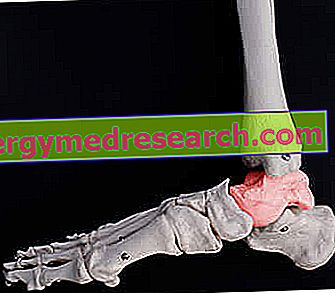Generality
The talus, or talo, is one of the seven bones that make up the tarsus of the foot. Together with the metatarsal bones and the phalanges, the tarsal bones form the skeletal scaffolding of the feet of the human being.

Astragalus is one of the bony elements that participate in the formation of the talo-crural joint, also known as an ankle properly so called; the others are the calcaneus (another bone of the tarsus of the foot), the distal end of the tibia and the distal end of the fibula.
Minimally vascularized, the talus can fracture like any other bone in the human body.
Brief anatomical reference to the foot
The anatomists divide the bones of the foot into three groups: the tarsal bones (or tarsal group), the metatarsal bones (or metatarsal group) and the phalanges.
- Tarsal bones or tarsal group or tarsus . Located just below the ankle joint, there are a total of 7 irregularly shaped bony elements.
- Metatarsal or metatarsal group bones or metatarsals . Belonging to the category of long bones, they are in all 5 elements, arranged parallel to each other. The proximal section is bordered by the cuneiform tarsal bones and the cuboid; the distal section, on the other hand, borders on the phalanges.
- Phalanges . There are a total of 14 and they represent the bony elements that make up the toes. Except the first finger - the only one formed by 2 phalanges - all the other fingers have 3 phalanges each.

What is astragalus?
The talus, or talo, is one of the seven tarsal bones, in other words one of the bony elements that make up the tarsus or tarsal group of the foot .
In close contact with the calcaneus (another tarsal bone), the astragalus forms an important articulation with the latter and with the malleoli of the tibia and fibula: the talocrural articulation or ankle properly so called (the only term ankle is widely diffused, but it is improper).
In addition to the talus and the calcaneus, the other bones of the tarsus are: the navicular, the cuboid, the lateral cuneiform, the intermediate cuneiform and the medial cuneiform.
Anatomy
Astragalus is an irregularly shaped bone element in which no muscles are inserted.
It is the second largest tarsal bone (the first is the calcaneus) and represents the bone structure of the human body with the largest percentage of cartilaginous tissue on its surface.
To simplify the study, anatomists tend to divide the astragalus into three portions or parts:
- The head;
- The neck;
- The body.
HEAD OF ASTRAGALUS
Oriented forward and slightly downward, the head of the talus is the most distal portion of the talo, ie the part closest to the toes (NB: in anatomy, "distal" means "farther from the center of the body" and it is opposed to proximal, which has opposite meaning).
It has three characteristic areas: an articular surface, on the front, and two "facets" (one medial and one lateral), on the lower surface.
The articular surface located on the front of the head is quite wide, oval and convex. Its role is to articulate the talus to the navicular bone.
The medial "facet" (in this case, medial means that "looks" towards the inside of the foot) is convex and triangular or semi-oval. On its surface it houses part of the so-called calcaneus-navicular plantar ligament, which has the function of supporting the head of the talus.

Finally, the lateral "facet" (lateral means that "looks" towards the outside of the foot) is a somewhat flattened surface, which has the role of articulating the talus with the "facet" present on the higher portion of the front of the heel; in simpler words, it connects the talo with the anterior and higher area of the heel.
The plantar calcaneo-navicular ligament is the formation of fibrous connective tissue, located on the lower edge of the foot, which goes from the calcaneus to the navicular bone.
NECK OF ASTRAGALUS
The neck of the talus is the narrow portion that resides between the head and the body of the talus.
It has several rough surfaces, which serve as an insertion point for different ligaments of the foot.
In particular, an area similar to a groove, called the groove of the talus, deserves a mention. In the area between talo and calcagno, the groove of the talus participates in the formation of the so-called sine of the tarsus (NB: it constitutes its roof, while the heel is its floor); the breast of the tarsus is a small cavity that houses blood vessels, nerves and important ligaments of the foot, such as the interosseous talo-calcaneal ligament and the cervical interosseous ligament. These ligaments are important because they have the function of proprioception during walking and guarantee stability to the foot.
Click here to view detailed anatomical tables of the talus
BODY OF ASTRAGALUS
Of the three parts that make up the talus, the body is the largest portion.
Equipped with a cuboid shape, it occupies a proximal position with respect to the neck and head and has the important task of articulating with the distal extremities of the tibia and fibula (NB: the bones of the legs), forming the talocrural articulation (or ankle properly so called ).
Anatomically, 5 surfaces can be identified in the body of the talus :
- The upper surface. Also called trochlear surface, this area is smooth, wider on the front than the back, convex only in the front and concave for the remaining part.
The upper surface of the body of the talus is closely related to the tibia: in fact, it fits into the so-called tibial mortar, a smooth hollow present on the lower surface of the distal end of the tibia.
The union between the upper surface of the body of the talus and the tibial mortar represents the main constituent element of the ankle properly so called.
Therefore, the upper surface of the body of the talus is a joint-like surface.
- The medial surface. It has two particularly important areas: an area with joint function and a small depression.
With a smooth consistency, the area with joint function is in continuity with the upper surface previously described and has the task of joining the medial surface of the body of the talus with the so-called medial malleolus (or tibial); the tibial malleolus is the bony prominence of the tibia, visible on the inner side of the anatomical region commonly called ankle. The connection between the medial surface of the body of the talus and the inner surface of the tibial malleolus gives stability to the talocrural articulation.
The small depression, on the other hand, is an area dedicated to the insertion of some deltoid ligaments of the ankle proper. Compared to the articular area, it occupies a lower position and has a rough consistency.
- The side surface. It has three areas of particular importance: an area with articular function, a small rough depression and a facet oriented towards the back side of the body of the talus.
Of smooth consistency and triangular shape, the area with articular function is in continuity with the upper surface described above and has the task of joining the lateral surface of the body of the talus with the so-called lateral malleolus (or peroneal); the peroneal malleolus is the bony prominence of the fibula, visible on the external side of the anatomical region indicated by the generic term ankle. The union between the lateral surface of the body of the talus and the internal surface of the peroneal malleolus gives stability to the talocrural articulation.
Passing, therefore, to the small rough depression, this is the area appointed to hook one of the two ends of an important ankle ligament properly called: the so-called anterior talo-fibular ligament.
Finally, the facet oriented towards the back side of the body of the talus is a triangular area, whose function is to support two ligaments of the ankle properly: the so-called posterior talo-fibular ligament and the so-called inferior tibio-fibular ligament rear.
- The back surface. It has two anatomically relevant areas: a deep groove, just below the upper surface of the body of the talus, and a bone process, in a lower position with respect to the aforementioned groove and moved towards the outside of the foot.
The bone process has the fundamental function of hooking an important ankle ligament properly called: the aforementioned posterior talo-fibular ligament.
- The lower surface. It is a fairly large anatomical area, with the task of articulating with the heel.
To delineate the front part, is the groove called the groove of the talus; groove of the talus which, as will be recalled, is the area implicated in the constitution of the so-called sine of the tarsus.
vascularization
Astragalus is poorly vascularized, so it lacks good blood supply.
The lack of an adequate blood supply means that the healing processes from possible bone fractures are very slow and require several months of waiting.
Functions
The function of the astragalus has already been widely discussed when the definition is given.
In this chapter, therefore, it is worth recalling, briefly, the function of the ankle properly so called and the importance of the connections between the lateral and medial surfaces of the body of the talus, respectively, with the peroneal and tibial malleoli.
ANKLE FUNCTION
The ankle properly so that it allows the foot to perform two fundamental and opposite movements: the plantarflexion and the dorsiflexion .
Plantarflexion is the movement that allows you to point your foot towards the floor. The human being performs a plantarflexion movement when he tries to walk on his toes.
Dorsiflexion, on the other hand, is the movement that allows you to lift your foot and walk on your heels.
IMPORTANCE OF THE UNION BETWEEN ASTRAGALUS AND MALLEOLS
Without the peroneal and tibial malleoli and without the conjunctions that these form, respectively, with the lateral and medial surfaces of the body of the talus, the talo would tend to "slip" out of the tibial mortar, especially when the foot is particularly moving. accentuated.
Development
The ossification center, from which the astragalus will derive, is usually formed between the 7th and 8th month of intrauterine life.
Diseases of the Astragalus
Like all the elements of bone in the human body, the astragalus can also fracture.
The most common astragalus fractures involve two of the three portions that make up the bone in question: the neck and the body.
In most cases, fractures of the neck of the talus are subsequent to excessive dorsiflexion of the foot. In fact, this movement causes the neck to press, in an abnormal and violent manner, against the tibia, breaking due to the impact. As they occur, these types of bone lesions can alter direct blood flow to the talus and lead to episodes of osteonecrosis (or avascular necrosis).
Moving on to the fractures of the body of the talus, these are, as a rule, the result of jumps carried out from an excessive height. In such circumstances, in fact, the body of the astragalus slams violently against the tibial mortar, thus suffering an injury.



